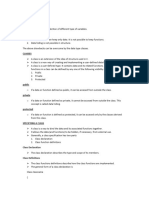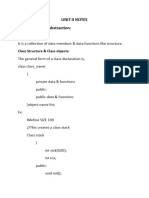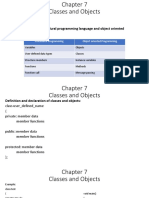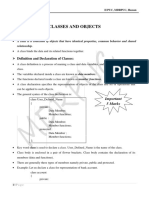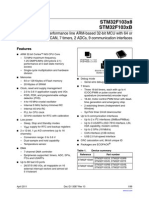0 ratings0% found this document useful (0 votes)
2 viewsDefining member functions & Memory Allocation for objects
Member functions in C++ can be defined either inside or outside the class definition, with the function body remaining the same but the header changing based on the location. Memory for member functions is shared among all objects of the class, while separate memory locations are allocated for member variables of different objects. Inline functions can be defined outside the class using the scope resolution operator, and memory is allocated when objects are created.
Uploaded by
akankshat2007Copyright
© © All Rights Reserved
Available Formats
Download as PDF, TXT or read online on Scribd
0 ratings0% found this document useful (0 votes)
2 viewsDefining member functions & Memory Allocation for objects
Member functions in C++ can be defined either inside or outside the class definition, with the function body remaining the same but the header changing based on the location. Memory for member functions is shared among all objects of the class, while separate memory locations are allocated for member variables of different objects. Inline functions can be defined outside the class using the scope resolution operator, and memory is allocated when objects are created.
Uploaded by
akankshat2007Copyright
© © All Rights Reserved
Available Formats
Download as PDF, TXT or read online on Scribd
You are on page 1/ 3
Defining Member Functions:
Functions Member functions can be defined in two places:
places: class number
1. Inside the class definition {
2. Outside the class definition.
definition. private:
private:
int a;
The function body is identical in both the cases only
public:
public:
function header is changed.
changed. void getdata()
getdata()
{
1. Inside the class definition “Enter any int number”;
number”;
General form / syntax : cin>>a
cin>>a;
>>a;
}
return data-
data-type function-
function-name ( arguments )
{ void display()
function body;
body; {
} cout<<“Number
cout<<“Number = ”<<a;
”<<a;
}
A member function can defined inside a class.
class. };
Normally small function are defined inside the class
definition and these functions are treated as inline
functions.
functions. channel link : https://www.youtube.com/c/ComputerScienceAcademy7
video link : https://youtu.be/EA57vk31qMk
2. Outside the class definition
Member functions which are not defined inside a class class number
have to be defined separately outside the class.
class. {
private:
private:
General form / syntax : int a;
public:
public:
return data-
data-type class-
class-name : : function-
function-name ( arguments )
void getdata()
getdata();
();
{ void display();
display();
function body;
body; };
}
void number : : getdata()
getdata()
Class – name : : is membership label.
label.
{
It tells complier that the function belongs to the class.
class. cout<<“Enter
cout<<“Enter any int number”;
number”;
The symbol : : is scope resolution operator.
operator. cin>>a
cin>>a;
>>a;
The scope of the function is restricted to the class - name }
specified in header line.
line.
void number : : display()
The functions which are defined outside the class {
definition can be made inline by using the qualifier inline in cout<<“Number
cout<<“Number = ”<<a;
”<<a;
the header line of the function definition.
definition. }
For example:
example: inline void number : : getdata ( );
Memory Allocation for objects
The memory space for member functions is allocated class number
{
when they are defined as a part of class specification.
specification.
private:
private:
All objects belonging to the class uses the same member int a;
functions.
functions. public:
public:
Separate memory locations for the objects are allocated void getdata(int
getdata(int x)
when they are declared.
declared. {
a = x; N1.a
Separate memory locations for the objects are essential
}
because the member variables will hold different data N2.a
values for different objects.
objects. void display()
Common for all object Memory created when {
function defined cout<<“Number
cout<<“Number = ”<<a;
”<<a;
Member function 1 }
Member function 2 };
void main()
Object 1 Object 2 {
Member variable 1 Member variable 1 number N1, N2;
Member variable 2 Member variable 2
N1.getdata(
getdata(10)
10); N1.display()
display();
();
N2.getdata(
getdata(20)
20); N2.display()
display();
();
Memory created when }
object defined
You might also like
- Static and Const: CSC-210: Object Oriented ProgrammingNo ratings yetStatic and Const: CSC-210: Object Oriented Programming23 pages
- Static data members & static member functionsNo ratings yetStatic data members & static member functions2 pages
- Unit-5 OOSD with C++ Notes_compressed_49156168_2024_12_27_00_38No ratings yetUnit-5 OOSD with C++ Notes_compressed_49156168_2024_12_27_00_3846 pages
- Static and Const: CSC-210: Object Oriented ProgrammingNo ratings yetStatic and Const: CSC-210: Object Oriented Programming17 pages
- Learn C++ - Functions Cheatsheet - CodecademyNo ratings yetLearn C++ - Functions Cheatsheet - Codecademy6 pages
- Practice Assignment - Classes and ObjectsNo ratings yetPractice Assignment - Classes and Objects4 pages
- C++ C++ Is A Superset of C.: Output OperatorNo ratings yetC++ C++ Is A Superset of C.: Output Operator39 pages
- Classes, Objects, Friend Function, Constructors & DestructorsNo ratings yetClasses, Objects, Friend Function, Constructors & Destructors27 pages
- Unit 5 Classes and Objects: Defining The Class in C++No ratings yetUnit 5 Classes and Objects: Defining The Class in C++7 pages
- Kotlin Fast Track Guide - 86 Key Points Every Programmer from Other Languages Should MasterFrom EverandKotlin Fast Track Guide - 86 Key Points Every Programmer from Other Languages Should MasterNo ratings yet
- Multi Class SVM - File Exchange - MATLAB CentralNo ratings yetMulti Class SVM - File Exchange - MATLAB Central2 pages
- (Progress in Theoretical Computer Science) Peter W. O'Hearn, Robert D. Tennent - ALGOL-like Languages. Volume 1-Birkhäuser Basel (1996)No ratings yet(Progress in Theoretical Computer Science) Peter W. O'Hearn, Robert D. Tennent - ALGOL-like Languages. Volume 1-Birkhäuser Basel (1996)284 pages
- IDce5251ec6-1996 Chevy Cavalier Manual DownloadNo ratings yetIDce5251ec6-1996 Chevy Cavalier Manual Download2 pages
- 68HC11 Microcontroller Trainers MCT-68HC11No ratings yet68HC11 Microcontroller Trainers MCT-68HC112 pages
- Following Is The VHDL Code For An 8-Bit Shift-Left Register With A Positive-Edge Clock, Serial In, and Serial OutNo ratings yetFollowing Is The VHDL Code For An 8-Bit Shift-Left Register With A Positive-Edge Clock, Serial In, and Serial Out4 pages
- (Kalasalingam Academy of Research and Education) Anand Nagar, KrishnankoilNo ratings yet(Kalasalingam Academy of Research and Education) Anand Nagar, Krishnankoil4 pages
- E-Letter: Ki51703 Se For Large Scale SystemNo ratings yetE-Letter: Ki51703 Se For Large Scale System14 pages
- Micro Link Information Technology Business College: Department of Software EngineeringNo ratings yetMicro Link Information Technology Business College: Department of Software Engineering34 pages







